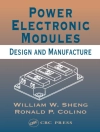Scaling an extrusion process (e.g., from pilot scale to production scale) or transferring a process from one type of extruder to another (of the same or different makes/models), involves an understanding of many process variables. This book takes a complex task, commonly approached largely on an empirical (or ‘trial and error’) basis and shows how scientific and engineering principles can be assembled to design the required outcome – that is, the manufacture of the same product.
Following a brief review of extrusion theory, the book discusses methods to quantify both material rheology and the extrusion process. Principles and application of ‘Dimensional Analysis’ techniques are also presented.
This is then used as a basis for a planned approach to scale-up and/or process transfer. Analysis and scale-up of extrusion dies are covered as separate topics. Worked examples – taken from actual industrial scale-up experience – are used to demonstrate the methods. The aim is to provide readers with a science-based approach to this topic, which applies to real industrial processes. The limitations inherent in scaling the process are also discussed, along with an outline of how small-scale trials should be planned so that processes are more scalable.
表中的内容
SECTION 1: Basic Principles of Extrusion Processing, Scale-Up & Dimensional Analysis
1. Basic Principles of Extrusion Processing & Scale-Up
2. A Review of Basic Extrusion Cooking Theory – The Four Golden Rules
3. Modelling & Measuring the Degree of Cook in Extrusion Technology
4. The Development of Optimal Screw Profiles
5. Potential Limitations to the Scale-Up of Extrusion Processes
6. An Introduction to the Principles of Dimensional Analysis
SECTION 2: Quantification of the Raw Materials, the Product & the Process
7. Quantification of the Extrusion Process – Raw Materials & Product Specifications
8. Quantification of the Extrusion Process – The Mass & Energy Balance
9. Weighted Average Total Strain (WATS)
SECTION 3: Process Scale-Up & Process Transfer Methodologies
10. The General Requirements for Extrusion Process Scale-Up
11. Scale-Up for Heat Transfer Controlled Extrusion Processes
12. Scale-Up for Mixing in Extrusion
13. Scale-Up via Empirical Models
14. Scale-Up via Supplier Data & Recommendations
15. Scale-Up of Extruders via Dimensional Analysis
SECTION 4: Application of the Principles of Dimensional Analysis in Extrusion Processing
16. Use of Dimensional Analysis – The Operational Characteristics of Extruders
17. Use of Dimensional Analysis – The Scale-Up of Extrusion Dies
18. The Use of Dimensional Analysis – The Prediction of Product Bulk Density
19. Use of Dimensional Analysis – The Extruder Venting Process
SECTION 5: Application of the Principles of Extrusion Process Scale-Up
20. Scale-Up of Single Screw Extruders – Pasta Press Scale-Up
21. Scale-Up of Twin Screw Extruders – The Manufacture of Crisp Bread
Appendix 1 – Application of the Buckingham π Theorem
Appendix 2 – Rules of Thumb for Dimensional Analysis
Appendix 3 – A List of Common Dimensionless Groups
Appendix 4 – A List of Dimensionless Groups for the Analysis of Extrusion Technology
Appendix 5 – Estimation of Material Thermal Properties
Nomenclature & Symbols
Technical References
Index
关于作者
Dennis Forte graduated in chemical engineering and spent ten years with the Mars Corporation in both process and product development roles within the areas of confectionery and pet food extrusion technologies. He moved on to work with The Uncle Toby’s Company as the Process Engineering Manager, where he was actively involved in the quantification and optimisation of ready-to-eat breakfast cereal and snack manufacture. He is has been practicing as an independent engineering consultant to the food industry since 2000, providing technical support, design expertise and training to a broad range of manufacturers.












